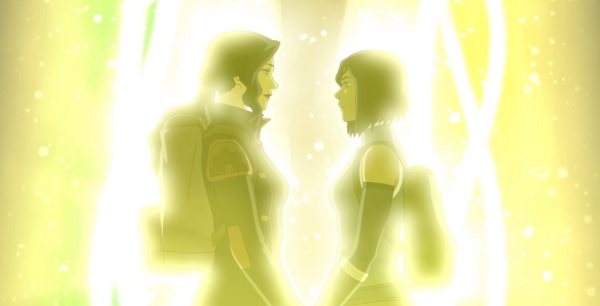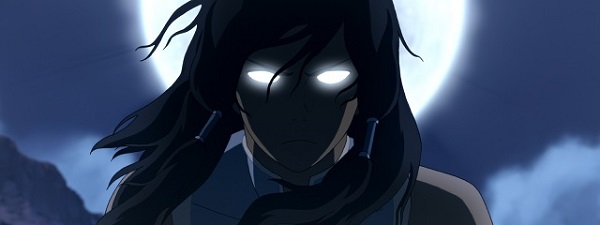It’s tricky to critique or even analyze a show like The Legend of Korra. The follow-up to the hugely successful Avatar: The Last Airbender had a more tumultuous run than its predecessor, to say the least. The show’s behind the scenes issues are notorious, with episode leakages and a move to online distribution that was made worse by Nickelodeon’s continued slashing of the series’ budget. Given all of these issues and probably many more, it would be a shock if the show was even passable. And The Legend of Korra is much more than passable.
The show’s end is still in recent memory and its final moments are some of its most powerful and uplifting — a triumph for both the LGBT and feminist communities. Korra’s social messages were not just evident as the series came to a close, though. They course through the show from beginning to end. Both Korra and the show that exists around her exude a maturity in gender dynamics that is rarely found anywhere on television, let alone on a “kid’s cartoon.”
Korra, the show’s main character, is nothing short of remarkable. Korra is hot-headed, naive, and complicated at the show’s start and gradually evolves into a composed and compassionate young woman by its end. In between, Korra does things that are infuriating and stupid. She’s the most powerful person in her world, but she’s often compulsive, even as she engenders constant sympathy. This may sound like inconsistency, but in truth, it has much more to do with complexity than it does confusion. Korra’s decisions, as wrongheaded as some of them may be, are always contextualized and never feel forced. She is a woman who is fiercely protective and nurturing, but also violent and unruly.
Korra’s complexity is deepened by her relationships with both the men and women that surround her. Early on, it is primarily her relationship with two men that define her. In Tenzin, Korra finds a mentor who is able to provide her with both wisdom and guidance. As someone who is disciplined and learned, Tenzin is able to instill a great deal of spirituality and thoughtfulness into Korra, who is introduced as someone in conflict with these ideals. Korra is able to learn about the nature of compassion and peace from Tenzin, and he proves to be essential in the development of her character.
Mako, Korra’s initial romantic interest, and eventual boyfriend, also figures prominently for Korra early on. After initially dating Asami, the wonderfully perfect daughter of a wealthy industrialist, Mako and Korra end up together as the first season comes to a close. The couple hits rocky water, however, in season two and eventually break up over their inability to focus on anything but their respective duties to the world that they both serve. This breakup, which comes after several episodes of the couple fighting, was a welcome one for most viewers and felt like a mature and natural way to end their relationship. More importantly, though, the couple’s realization that their relationship didn’t work is one that actually sticks. They stay broken up and continue to work together as friends who support and admire one another.
If these men define the beginnings of Korra’s development as a character, it is the women on The Legend of Korra who mark the end of it. Though she was introduced in the first season, Lin Beifong’s development in the later seasons is a prime example of the complexity this show always afforded to its female characters. Initially, viewers found the daughter of Avatar heroine Toph working as Republic City’s chief of police. Lin seems tough, in control, and put together here, a hero who eventually sacrifices herself in order to save Tenzin and his family. It is in season three, however, when Lin’s development begins in force as viewers are given insight into her complicated relationship with both her sister and mother. In this arc, Lin is childish and difficult. She’s angry and impulsive. She’s undone by a family she long ago decided to ignore. The arc makes it clear that Toph, a character that Avatar fans treasured dearly, had a lot of trouble raising children. She messed them up. Lin’s arc here proved that Korra the show had time for female characters that weren’t in the title.
Kuvira, Korra’s final nemesis, is a character whose progression and story prove to deepen the audience’s connection not only to her but to what Korra has been through as well. In addition to being the show’s first female big bad, Kuvira is one of its most sympathetic. Though her attempt to create a united Earth Kingdom undoubtedly went too far, it all stemmed from her need to find a family and feel there was someplace where she was at home. As an orphan, Kuvira longed for control that always seemed just out of her grasp and when she finally attained some, it proved to be too much for her. Korra sees herself in Kuvira, someone who is brave, intelligent, and rash, but is also deeply wounded by her past. This sympathy is Korra’s final step in becoming a sympathetic, wise leader who would rather reason with her enemies than fight them. Korra’s ability to sympathize with Kuvira at all signifies a great deal of growth for her character. In the show’s first season, she had no desire to understand her enemies. She was the avatar, a master bender whose enemies should tremble before her.
Then, of course, there’s that ending. After opening a new spirit portal in the center of Republic City, Korra and Asami decide to go on a vacation together in the spirit world. Every aspect of this ending is significant. The choice to focus on Korra and Asami’s relationship is a significant one, even without the lesbian undertones of the final images. The creators are saying here that this show is one about relationships between people, independent of gender. Korra gets real closure with Mako, Tenzin, and Asami as the series comes to a close and by ending with Asami, the writers crystallize the relationship that mattered most to Korra throughout the show, especially in its later seasons. Of course, Asami’s gender is significant, but even on top of the social impact that this ending could have, it also makes sense within the world of the show, and that may be what is more important.
The choice to end the show with Korra venturing into the spirit world also provides an end to her spiritual journey. Korra, who hated meditating in season one, is connected with her spiritual self to the extent that she is unafraid of entering the spirit world and is willing to enter it freely and frequently. This is emblematic of another aspect of Korra’s journey, which was frequently one of self-discovery. When Korra is first introduced as a child, her first line is, “I’m the Avatar and you gotta deal with it!” It’s a cute and endearing moment, one which instantly allows viewers to bond with the character. It also functions as an incredible summation of Korra’s beliefs about herself and her identity. Korra sees herself not as a person, but as the avatar, and puts her duties in this role above everything else. It is not until season two, when she sees how the first avatar came to be, that she comes to realize that it is not a separate force that truly makes her powerful. While it may be true that her powers as an avatar initially came from external spiritual entities, Korra’s inner spirit is even more powerful and it is what ultimately allows her to be the great leader that she becomes. Korra discovers herself and ultimately comes to derive her power from this, not from the larger forces which attempt to intervene in her life.
Asami is Korra’s best friend. She cares for Korra, attempts to help her with whatever problems may arise for her, and looks to Korra for the same support. Their friendship, for as long as it’s existed, has been built on this kind of give and take. This is evidenced in their last interaction, during which Korra first seeks out Asami for comfort, asking her to sit for a while. Later in the same conversation though, the roles are reversed as Korra comforts Asami after the loss of her father. It’s a relationship built on parity, and neither exists purely for the support or the benefit of the other. As the show’s creators have confirmed, the ending between the two is a romantic one. This not only functions well within the world of the show, it is also a significant step for LGBT representation on television. Korra and Asami’s relationship is among the first lesbian or bisexual ones in the history of children’s television, and its historical significance should not be undercounted. 
Outside of its politics, or perhaps in part because of them, The Legend of Korra was one of the best shows on television in 2014. Korra’s journey is one of the most complex, interesting explorations of one person that has ever existed on television. In its four seasons, The Legend of Korra told a story about one woman’s journey to self-realization. She got to learn and grow and make mistakes, and she saved the world along the way. This is why The Legend of Korra succeeded, and why its viewers are so very thankful that it did.




